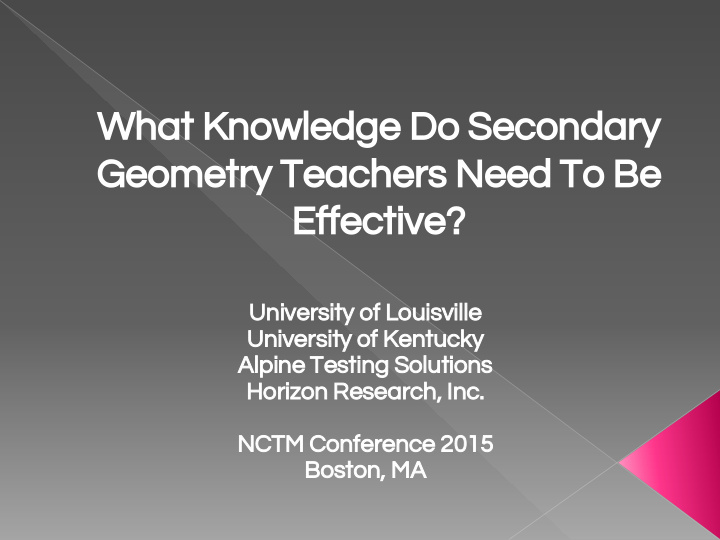



What Knowledge Do Secondary Geometry Teachers Need To Be Effective? University of Louisville University of Kentucky Alpine Testing Solutions Horizon Research, Inc. NCTM Conference 2015 Boston, MA
Presenters ⦿ Margaret Mohr-Schroeder, University of Kentucky ⦿ Susan Peters, University of Louisville ⦿ Robert Ronau, University of Louisville ⦿ Carl Lee, University of Kentucky ⦿ William S. Bush, University of Louisville ⦿ Kayla Blyman, University of Kentucky
GAST – Geometry Assessments for Secondary Teachers ⦿ Source—National Science Foundation DR-K12 Program ⦿ Amount - $3,081,716 ⦿ Duration— 6 years (October 2008- December 2014)
Primary Goal of GAST To improve high school geometry teaching through the development of geometry assessments for teachers that provide predictive validity with regard to teaching performance and student achievement in geometry
Goal of this Presentation Teaching foundational geometry concepts such as surface area/volume and similarity/congruence in a climate of high stakes testing can be a daunting and challenging task. This presentation will report research results revealing what factors impact student achievement in secondary geometry classrooms.
Project Activities ⦿ Analysis of Textbooks, Standards, Videotaped Lessons ⦿ Development of GAST Blueprint ⦿ Item-writing ⦿ Assessment Development—Two Forms A and B ⦿ Development of a Classroom Observation Tool ⦿ Validity Study with Regard to Teaching Performance and Student Achievement
Geometry Content Assessed on GAST ⦿ Focus on geometric topics: similarity/ congruence, surface area/volume ⦿ Performance of geometric skills ⦿ Understanding of geometric concepts, skills, generalizations ⦿ Performance of mathematical processes (problem solving, reasoning) (NCTM) ⦿ Pedagogical content knowledge
Knowledge Types ⦿ Used Webb’s (1997) Depth of Knowledge Indicators › Skills and Procedures (DOK 1) › Conceptual Understanding (DOK 2) › Problem Solving/Reasoning (DOK 3) › Did not use DOK 4 because hard to assess in proposed format ⦿ Pedagogical Content Knowledge
Validation Study ⦿ 173 high school geometry teachers from across the United States ⦿ Data collected: ✓ Teaching moves during instruction ✓ Teacher and student mathematical tasks during instruction (DOK) ✓ Teacher performance on GAST ✓ Student performance on Usiskin Geometry Readiness Test ✓ Student performance on end-of-course Geometry Test (KY )
What we found out ⦿ Pedagogical content knowledge has greater predictive power for student learning than content knowledge ⦿ Student readiness was an even great predictor ⦿ BOTH strong content knowledge and pedagogical content knowledge are necessary for impact on student achievement ⦿ Specifically, teacher performance on DOK 3 items and DOK 3 performance in the classroom revealed higher levels of student achievement
Let’s Try Some Out! ⦿ A cylinder has a volume of 200 cubic units. Derive and express the surface area of the cylinder as a function of its radius.
Sample Item Pedagogical Content Knowledge A cube 4 units on a side has each of its corners sliced off with each cut intersecting the original edges 1 unit from the original corners. Students are asked whether these cuts have increased or decreased the surface area. One student argues that the surface area has increased because the cuts produced new surfaces. Another student argues that the surface area has decreased because the new object is smaller than the original. Describe an activity that would convince other students which student was correct.
The inner boundary ABCD and the outer boundary EFGH of a race track each consists of two straight parallel segments and two semi-circular arcs. Is the outer boundary similar to the inner boundary? Explain your response clearly.
Pedagogical Content Knowledge
What does this look like in the classroom? In most instances, requiring students to explain and justify ⦿ their reasoning and thinking is Level 3 › The idea is to move from describing the “what and how” to justifying the “what and how” through application and evidence Activities that require the students to make conjectures and ⦿ generalize are also Level 3 Multiple answers to a question does not indicate level 3 ⦿ necessarily – rather, the task should demand reasoning Level 3 (Strategic Thinking) Depth of Knowledge requires ⦿ reasoning, developing a plan or a sequence of steps and some complexity – e.g., more than one reasonable approach
Examples of DOK 3 Classroom Tasks ⦿ Drawing conclusions from observations ⦿ Generalizing patterns– writing mathematical rules for non-routine patterns ⦿ Citing evidence, and developing logical arguments ⦿ Identifying and justifying solutions ⦿ Supporting ideas with details and examples ⦿ Explaining phenomena in terms of concepts
DOK 3 Classroom Questioning ⦿ How is related to ? ⦿ What conclusions can you draw ? ⦿ How would you adapt to create a different ? ⦿ What would happen if ? ⦿ Can you formulate a conjecture for ? ⦿ Can you elaborate on the reason?
Next Steps ⦿ Make GAST Test more widely available ⦿ Crunching more data and disseminating more results
Questions ⦿ Do you have any questions or comments? ⦿ Handout is available online – NCTM online program › Click on the pdf symbol next to presentation Want more information? Please contact Tom Tretter, co-director of the Center for Research in Mathematics & Science Teacher Development at the University of Louisville, at tom.tretter@louisville.edu
Recommend
More recommend